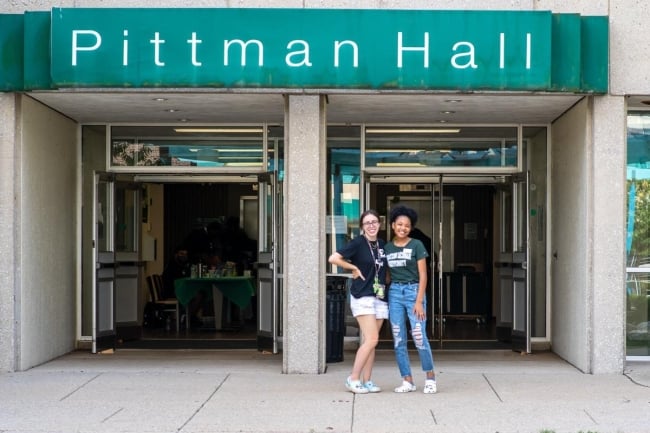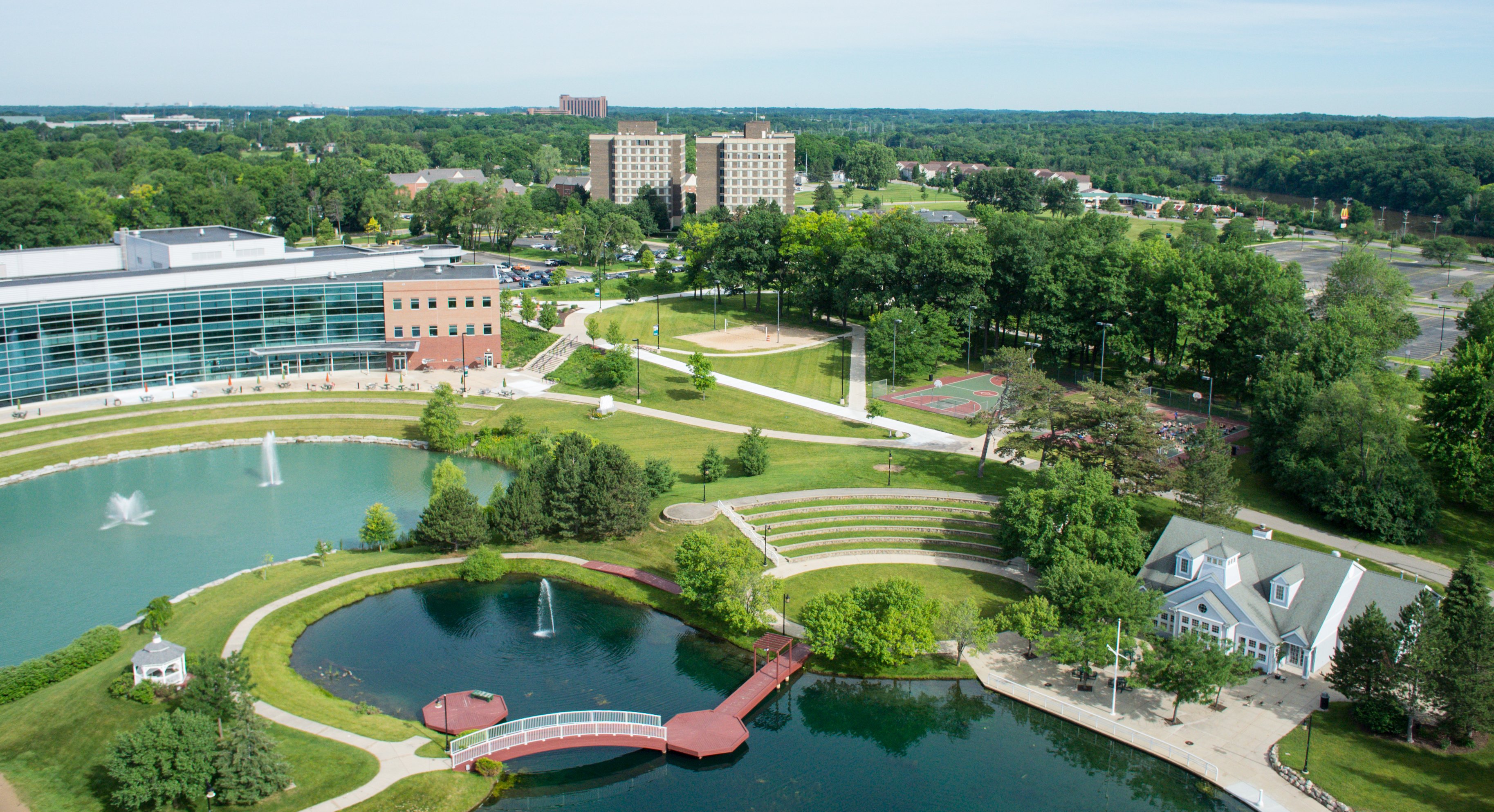You have /5 articles left.
Sign up for a free account or log in.

EMU students pose in front of Pittman Hall, one of six residence halls set to be demolished as part of the university’s student housing overhaul in partnership with private Gilbane Developers.
Courtesy of Eastern Michigan University
When Christina Trotter, a rising sophomore at Eastern Michigan University, was asked what her priorities were for new and improved campus housing, one thing immediately came to mind: air-conditioning. Record high temperatures have gripped Michigan this summer, and many of the dorms on the Ypsilanti campus are old; only one has central air.
“I had my box fan going all year; [my roommates and I] were wearing shorts and tank tops every day,” Trotter said. “Definitely air-conditioning was something my friends and I agreed on.”
AC is just one item on a list of improvements and amenities that university leaders want to bring to residence halls, in addition to more communal space, better Wi-Fi, upgraded appliances and a more modern style. But for years the institution has lacked the resources to do so.
EMU officials say that will soon change thanks to a new public-private partnership. In June, the university’s Board of Regents approved a 35-year, $200 million agreement with Gilbane Developers for the construction of two new dorms, the demolition of a half dozen old buildings and the outsourcing of maintenance costs and renovations for the remaining residence halls. And, of course, there will be AC in every room.
“We have students who want to live on campus, but we have buildings that have not been able to be maintained in the way we want them to be,” said Jeanette Zalba, EMU’s director of housing and residence life. “This partnership really gives us the opportunity to make these spaces not only new but also exciting.”
To pay for it, EMU will surrender all of its student housing fees to a third party, EMU Campus Living LLC, which will use the money to pay Gilbane for construction and maintenance costs as well as for university residential life services.
The deal, which is all but finalized, will essentially lease all of EMU’s student housing stock to a private developer for at least the duration of the contract. University officials say the partnership allows them to finance an overhaul of student housing while keeping the cost to students relatively stable.
Not everyone on campus is happy with the arrangement. In December the university’s Faculty Senate passed a vote of no confidence in President James Smith, CFO Michael Valdes and Smith’s chief of staff, Leigh Greden, in large part due to the administration’s handling of the deal.
“Pushing to sell off student dorms in the middle of a pandemic was the straw that broke the camel’s back,” Suzanne Gray, chair of EMU’s Faculty Senate, said in a press release following the vote last year. “The administration made a big show of soliciting ‘input’ [on the project], but it is clear that this decision had already been predetermined.”
“I feel like we’ve done everything we can around engagement,” Valdes said. “I understand that there are faculty members who have a different perspective.”
Robert Carpenter, education professor and chair of the Faculty Senate’s resource and budget committee, said the partnership with Gilbane is the latest in a series of privatization efforts undertaken by the university, including in campus dining and parking, among other services. He’s worried that in the pursuit of private funding solutions, the university has failed to consider the full effects of surrendering large revenue streams such as parking and rent.
“As we saw more and more dominoes fall to privatization, faculty became concerned,” he said. “There needs to be some deep conversations about priorities and how we can come up with innovative internal solutions through budgeting.”
Zalba said she understands that some level of control will be lost in partnering with Gilbane, but she feels whatever sacrifice is made will be worth it.
“If there’s something that’s lost or that people sense we’re losing, the gains are much greater,” she said. “We’re doing something that, for all the control we had before, we couldn’t do.”
Catching Up to the Competition
EMU has been struggling with enrollment declines since before the pandemic. Total enrollment fell by 25 percent from 2016 to 2021, according to a recent study by the National Student Clearinghouse Research Center.
 Some reasons for the dip are entirely out of EMU’s control; Michigan’s demographic shift and low birth rate have most colleges in the state looking at a decline in enrollment. But EMU’s strategy takes that into account: while many public-private student housing partnerships stem from a need to expand student housing, the EMU campus will hold about 1,000 fewer beds after the Gilbane arrangement is finalized.
Some reasons for the dip are entirely out of EMU’s control; Michigan’s demographic shift and low birth rate have most colleges in the state looking at a decline in enrollment. But EMU’s strategy takes that into account: while many public-private student housing partnerships stem from a need to expand student housing, the EMU campus will hold about 1,000 fewer beds after the Gilbane arrangement is finalized.
Valdes said the university’s outdated residence halls have contributed to the enrollment decline, and surveys of almost 2,000 students show a strong desire for improved dorms.
“We haven’t been able to invest in the properties to make them modern and consistent with what today’s student is looking for,” he said. “We feel like that’s been a competitive disadvantage for us.”
Lander Medlin, president of APPA, an association of physical plant administrators that serves as a national resource for educational facilities, said renovating student dorms and other facilities is a good strategy for both recruitment and retention.
“We know that 67 to 70 percent of parents and students make a decision whether to come to the institution or not based on the look and feel of the campus on that first impression, in the first 10 minutes,” Medlin said. “So part of it is about curb appeal, but you also want to create an environment where students feel a sense of belonging in a way that helps them identify meaningfully with the institution.”
Colleges and universities are increasingly turning to private developers to expand, improve and maintain their aging facilities. According to a 2021 report by Ernst & Young, in 2003 there were only three public-private partnerships (P3s) in higher education, worth a total of $100 million. In 2016, some 30 P3 deals—worth over $3 billion—were signed, and by 2021 $11 billion worth of P3 agreements were under negotiation, according to last year’s “Higher Ed P3 State of the Industry Report” from management firm Brailsford & Dunlavey.
Just 45 minutes down the interstate from EMU, Wayne State University inked a 40-year, $308 million deal with Corvias Property Management in 2017 to expand and modernize student housing. Western Michigan University and Northern Michigan University have also entered P3 campus housing agreements. Zalba said those were wake-up calls that helped accelerate EMU’s foray into private development, especially as Michigan’s smaller public universities compete in the same fast-shrinking market. (This paragraph has been updated to reflect the institutions that have already entered into P3 agreements.)
“Given that we’re in the same boat, we have to maintain a competitiveness to students who are looking at all these schools,” she said. “We want to offer something that is just as exciting.”
Trotter, the rising sophomore, said she and her friends already have their hearts set on living in a new student apartment building as upperclassmen.
“I’m excited for all the future students that will get to experience the new housing, and I hope it brings a lot of new students to EMU who might not have considered it before,” she said. “I wish I was a couple years younger so I could live in the new dorms all four years. That would be awesome.”
The Cost of Privatization
The P3 boom in higher education has come with a new set of problems for some universities, raising questions about institutional autonomy under these agreements.
In May 2020, as universities across the country prepared to go remote in response to the pandemic, institutions that had partnered with the private developer Corvias—including the University System of Georgia and Wayne State in Detroit—received letters reminding them of their debt obligations and the importance of filling campus beds to pay them.
Issues with maintenance and upkeep have arisen as well. At Howard University, where Corvias manages 60 percent of campus housing, students slept in tents and on air mattresses outside the campus center for over a month to protest mold, mice, flooding and other unsanitary conditions they said had gone unaddressed by the property managers.
Valdes said the example of Howard and other schools in similar predicaments informed EMU’s insistence on an oversight council for Gilbane’s maintenance and cleaning services, with financial disincentives attached to poor performance.
“We definitely went to school on what projects worked well and what projects didn’t,” he said.
“There are other institutions where an outside company builds it, runs it and manages it, and it’s in some ways removed from the philosophy of the institution,” Zalba said. “That is not the case here at all.”
Donald Cohen, founder and executive director of the research and public policy center In the Public Interest, said that beyond specific incidents like those at Howard and Wayne State, there are costs to the encroachment of private companies on higher education.
“You lose the public purpose of higher ed as a public good: the expansion of knowledge, a more educated populace, a more robust economy,” said Cohen, who is also the author of The Privatization of Everything (The New Press, 2021). “To the extent that you add private interests, you weaken the public purpose … they’re not just conflicting interests, they’re competing interests.”
Cohen also said that with less direct oversight of maintenance, cleaning and upkeep costs, it may end up being more expensive in the long term for universities to outsource to a private property manager, which in turn will often subcontract for specific services.
“It’s all legitimate business activity, but there’s money going from students and families to this company, and the company is skimming off the top, because that’s how they work,” he said.
Carpenter, the EMU education professor, said there’s been a “fundamental shift” toward privatization in higher education, which he attributes to two primary factors: the defunding of higher education by state legislatures and the growing corporatization of university structure and top leadership.
“I think there’s an ideological tension between faculty, who tend to see higher education as a public good, and administration, but especially boards of universities, because most board members come from the corporate world,” he said. “I fear there are folks around campus now who don’t see students as students, but as revenue sources.”
Carpenter said this means university leaders, when faced with funding issues, are more likely to turn first to corporate solutions like private partnerships and outsourcing.
“There’s the old saying in activism,” he said. “‘If the only tool in your tool belt is a hammer, everything looks like a nail.’”





